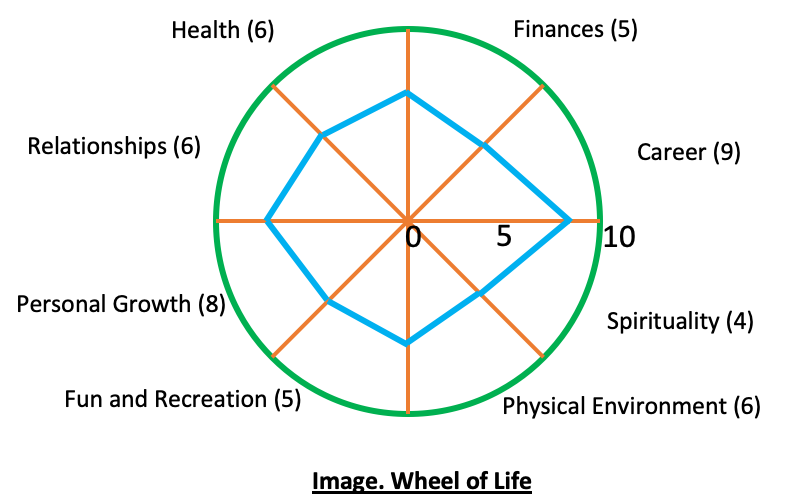Table of Contents
In the pursuit of self-improvement and effective goal setting, one tool stands out for its simplicity and comprehensiveness: the Wheel of Life. This concept, widely used in coaching and personal development, offers a visual representation of the various aspects of life, helping individuals identify areas that need attention and create balanced, actionable plans for improvement. This blog delves into the intricacies of the Wheel of Life, providing a step-by-step guide on how to use it for self-improvement and goal-setting.
“Be careful what you water your dreams with. Water them with worry and fear and you will produce weeds that choke the life from your dream. Water them with optimism and solutions and you will cultivate success. Always be on the lookout for ways to turn a problem into an opportunity for success. Always be on the lookout for ways to nurture your dreams.” – Lao Tzu
Understanding the Wheel of Life
The Wheel of Life is a circular diagram divided into segments, each representing a different area of life. Common categories include:
- Career
- Finances
- Health
- Relationships
- Personal Growth
- Fun and Recreation
- Physical Environment
- Spirituality
These categories can be customized to fit individual preferences and priorities. The purpose of the Wheel of Life is to provide a holistic overview of one’s life, allowing for a clear visual representation of areas that are flourishing and those that may need more focus.
Creating Your Own Wheel of Life
To create your own Wheel of Life, follow these steps:
- Draw the Wheel: Start by drawing a large circle on a piece of paper. Divide this circle into 8 equal segments, like a pie chart. Label each segment with one of the life categories that are most relevant to you.
- Evaluate Each Area: On a scale from 1 to 10, with 1 being very dissatisfied and 10 being fully satisfied, rate your current level of satisfaction in each area. Be honest with yourself; this is a personal assessment, and the goal is to gain a true understanding of your life as it is now.
- Plot Your Scores: Mark your scores in each segment, with the center of the circle representing 0 and the outer edge representing 10. Connect the dots to form a shape within the circle. This shape will give you a visual representation of your life balance.
- Analyse the Shape: Look at the shape you’ve created. Is it well-rounded, or does it have significant dips in certain areas? A well-balanced wheel is typically more circular, while an unbalanced one will look more jagged, indicating areas that need more attention.

Setting Goals Based on the Wheel of Life
Once you have a clear picture of your current life balance, the next step is to set goals to improve it. Here’s how to use the Wheel of Life for effective goal setting:
- Identify Key Areas for Improvement: The first step in setting goals based on the Wheel of Life is to focus on the segments with the lowest scores. These areas are the ones where improvement will likely have the most significant impact on your overall well-being. For instance, if you rated your career satisfaction at a 3, but your health at a 7, it makes sense to prioritize career-related goals since they currently represent a more substantial area of dissatisfaction. By concentrating on the most critical areas, you ensure that your efforts are directed where they can produce the most meaningful changes in your life.
- Set SMART Goals: After identifying the key areas for improvement, the next step is to set SMART goals for each of these areas. SMART stands for Specific, Measurable, Achievable, Relevant, and Time-bound. This framework helps ensure that your goals are clear and attainable. For example, if you rated your health at a 4, a SMART goal might be: “I will exercise for 30 minutes, five times a week, for the next three months to improve my physical health.” This goal is specific (30 minutes of exercise), measurable (five times a week), achievable (reasonable time commitment), relevant (improving health), and time-bound (three months). Setting SMART goals provides a structured approach that increases the likelihood of success.
- Create an Action Plan: With your SMART goals in place, the next step is to create an action plan. This involves breaking down each goal into smaller, manageable steps, making it easier to start working towards them and maintaining motivation. Continuing with the health example, your action plan might include researching different workout routines to find ones you enjoy, scheduling exercise sessions into your weekly calendar, and preparing healthy meals in advance to support your fitness goals. By detailing these steps, you create a roadmap that guides your daily actions and keeps you on track towards achieving your goals.
- Monitor Your Progress: Monitoring your progress is crucial to ensure that you stay on track and make necessary adjustments along the way. Regularly check in with your Wheel of Life to assess your progress. This could be done monthly or quarterly, depending on your preference and the nature of your goals. During these check-ins, update your ratings for each segment and review the effectiveness of your action plans. If you find that certain strategies aren’t working as well as anticipated, don’t hesitate to adjust your approach. Continuous monitoring and adjustment help maintain momentum and ensure that you’re always moving forward.
- Celebrate Achievements: Finally, it’s important to recognize and celebrate your achievements, no matter how small. Celebrating your successes provides positive reinforcement, which helps build momentum and keeps you motivated to continue working towards your goals. Whether it’s treating yourself to something special or simply taking a moment to reflect on your progress, acknowledging your accomplishments is a vital part of the goal-setting process. It reinforces the value of your efforts and encourages you to keep striving for improvement.
The Benefits of Using the Wheel of Life
The Wheel of Life offers numerous benefits for those looking to improve themselves and set meaningful goals, making it an invaluable tool in the journey towards personal and professional development:
- Holistic Perspective: It encourages a comprehensive view of life, ensuring that no area is neglected. This holistic approach promotes a more balanced and fulfilling life.
- Clarity and Focus: By identifying specific areas that need improvement, the Wheel of Life helps you focus your efforts where they will be most effective.
- Motivation: Seeing a visual representation of your progress can be highly motivating. It serves as a reminder of how far you’ve come and what you’re working towards.
- Adaptability: The Wheel of Life is highly adaptable, allowing you to customize the categories and goals to fit your unique circumstances and aspirations.
- Continuous Improvement: Regularly revisiting and updating your Wheel of Life fosters a mindset of continuous improvement. It encourages you to keep striving for better, regardless of where you currently stand.
Practical Examples
To better understand how to use the Wheel of Life for self-improvement and goal setting, let’s look at some practical examples:
- Career: Imagine you rate your career satisfaction at a 5 out of 10. This indicates a significant opportunity for improvement. To elevate this rating to an 8 within six months, you might consider a variety of specific actions. For example, seeking additional training or certifications relevant to your field can enhance your skills and make you more competitive. Networking more effectively, both within and outside your current organization, can open new opportunities and provide valuable insights. Additionally, exploring new job opportunities, either within your current company or with different employers, can lead to a more satisfying and rewarding career path.
- Relationships: If you rate your relationships at a 6, it suggests room for enhancement in your social connections. Setting a goal to spend more quality time with loved ones can have a profound impact. This could involve planning regular date nights with your partner, ensuring that you both have dedicated time together free from distractions. Scheduling weekly catch-ups with friends can help maintain and strengthen those bonds. Additionally, being more present and attentive during family time, such as putting away electronic devices and engaging in meaningful conversations, can deepen your relationships and create lasting memories.
- Personal Growth: A low rating in personal growth indicates a need for self-investment. You might set a goal to read one self-improvement book per month, which could introduce new ideas and strategies for personal development. Alternatively, attending personal development workshops can provide hands-on learning experiences and the opportunity to connect with like-minded individuals. To support these goals, you could create a reading schedule to ensure you dedicate time each day or week to your book. For workshops, researching available options and enrolling in those that align with your interests and goals can set you on a path of continuous learning and improvement.
- Health: A low rating in health calls for actionable steps to enhance your physical and mental well-being. Goals might include improving your diet by incorporating more whole foods and reducing processed foods, increasing physical activity by committing to regular exercise, and managing stress better through practices like mindfulness meditation. Specific steps could involve meal planning to ensure you have healthy options readily available, joining a fitness class to provide structure and motivation for your workouts, and setting aside time each day for mindfulness or relaxation exercises to reduce stress and improve mental clarity.
Overcoming Challenges
Using the Wheel of Life is not without its challenges. Here are some common obstacles and how to overcome them:
- Lack of Time: Balancing multiple goals can be time-consuming. Prioritize your goals and focus on the most critical areas first. Remember, it’s okay to start small and gradually build up.
- Procrastination: Setting goals is easy; taking action is harder. Combat procrastination by breaking goals into smaller steps and setting deadlines for each. Accountability partners can also provide motivation and support.
- Maintaining Motivation: It’s natural for motivation to wane over time. Keep your goals visible, review your progress regularly, and celebrate your successes. Adjust your goals as needed to keep them relevant and challenging.
- Fear of Failure: Fear of not achieving your goals can be paralyzing. Shift your mindset to view failures as learning opportunities. Each setback is a chance to reassess and improve your approach.
Conclusion
The Wheel of Life is a powerful tool for self-improvement and goal setting. By providing a clear, visual representation of your life balance, it helps you identify areas that need attention and create actionable plans for improvement. By setting SMART goals, creating detailed action plans, and regularly monitoring your progress, you can achieve a more balanced and fulfilling life. Embrace the Wheel of Life as a guide on your journey of continuous improvement, and you will find yourself achieving goals you once thought were out of reach.















